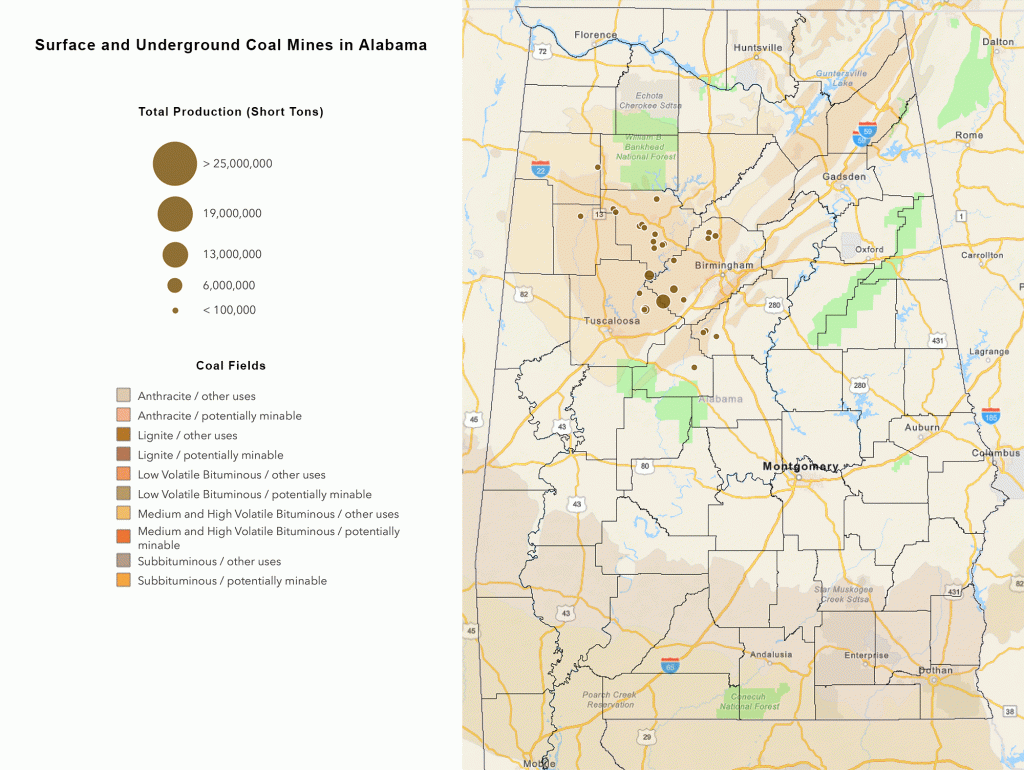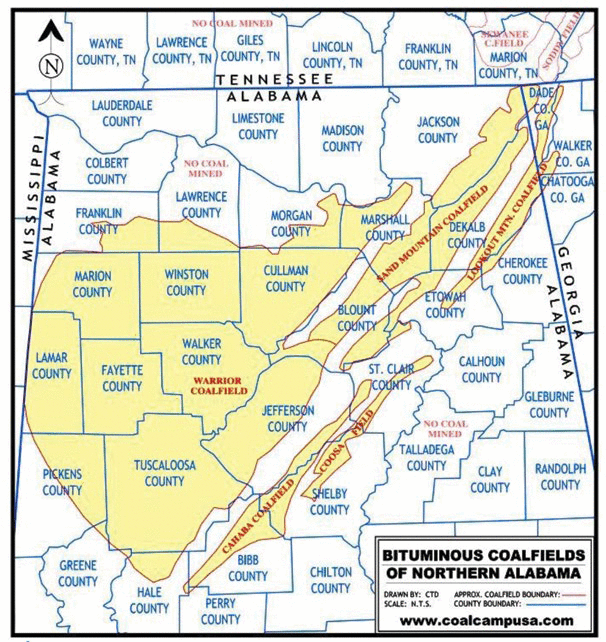INTRODUCTION
The Alabama coal industry and its supporting suppliers currently employ over 3,000 full-time- equivalent (FTE) employees and generate approximately $370 million in annual payroll. The industry average payroll is well over $100,000 per annum, making it one of the highest paid industries in Alabama, 1.6 times greater than average gross salaries in the state.
Alabama is ranked 14th in total coal production and 8th in bituminous coal production in the U.S. The overall coal production in 2018 was estimated to be approximately 13.5 million short tons. Met coal production accounted for 11 million tons or 82 percent of the state’s coal production, while thermal coal made up the remaining 2.5 million tons or 18 percent of overall production.
Coal has been mined commercially in Alabama since the 1850’s. In early years, coal was the single most important natural resource assisting in the transition of Alabama’s economy from an agriculturally-based to an industrialized economy through supporting the state’s development of the iron and steel industry. Later, coal mining was the catalyst in making Alabama become an energy producing and export-based economy.
Coal is the largest and most widespread fossil fuel resource. It accounts for 23 percent of the world’s known energy sources.6 Based on the “Demonstrated Reserve Base” data, Alabama holds about 4 billion tons of economically recoverable coal reserves. Using the EIA data, we estimate that 85% of that reserve is met coal. At Alabama’s current rate of met coal production – 11 million short tons per year in 2018- the state’s met coal resources will last for another 309 years, making it Alabama’s most lasting fossil fuel resource.


Alabama’s five bituminous coalfields are listed below. Most of the state’s 23 active surface and underground coal mines are located in the Warrior Coalfield. The top coal-producing counties in 2018 were Tuscaloosa, Jefferson and Walker.
- Cahaba Coalfield (St. Clair, Jefferson, Shelby, and Bibb Counties)
- Coosa Coalfield (St. Clair and Shelby Counties)
- Lookout Mountain Coalfield (Dekalb, Cherokee, & Etowah Counties)
- Sand Mountain Coalfield (Jackson, Dekalb, Etowah, Marshall, and Blount Counties)
- Warrior Coalfield (Jefferson, Tuscaloosa, Fayette, Walker, Winston, and Marion Counties)
METALLURGICAL COAL (IMAGE)
Met coal worldwide is less abundant and more valuable than thermal coal. Alabama’s met coal contains very low sulfur and has strong coking properties, making it ideally suited for steel makers. Around 70% of global steel production is dependent on met coal. Most of the met coal mined in Alabama is exported to steel makers in Europe, Asia, and South America via the Port of Mobile.
Three companies — Warrior Met Coal, Peabody Energy, and Murray Energy Corp — produce over 95 percent of all met coal mined in Alabama. One mine, Warrior Met Coal’s Mine #7, is responsible for 43 percent of the state’s total 11 million tons of met coal production. The dollar value of the met coal produced in Alabama during 2018 is estimated at $2 billion.
In 2018, 2,050 Alabamians were directly employed by the state’s met coal producers, which generated an annual payroll of approximately $288 million. Today, the average starting salary for an underground miner in the state’s met coal industry is $85,000 and increases to more than $100,000 after the first two years on the job.10 The United Mine Workers of America (UMWA), a labor union that advocates for the safety and health of its members, represents miners who are employed by each of the state’s three major met coal producers.
Modern coal mining is a stark contrast from the historical photographs that often shape the profession’s public image. Today, each of Alabama’s underground met coal mines utilize safe and highly efficient longwall mining technology, which require a skilled workforce of miners to operate and maintain. A state-of-the-art, fully automated longwall mining system costs around $100 million and consists of self-advancing hydraulic ceiling supports called shields, which extend over 1,000 ft when assembled, a shearer that cuts a thin layer from face of the coal seam with each pass, and a plow system that moves the coal onto a conveyor system and takes it out of the mine. Longwall mining requires a team of engineers and highly skilled miners to support high-voltage electrical power distribution, maintain complex hydraulic systems, and install the dynamic mine ventilation systems that isolate and remove methane and dust during the mining process.
The state of Alabama has taken note of the high-paying skilled jobs provided by the met coal industry. The legislature appropriated $950,000 in the state’s 2020 Education Budget to expand the mine training center located at the Sumiton campus of Bevill State Community College.
The economic impact of Alabama’s met coal industry extends far beyond the mine. The export of met coal drives economic development at the Port of Mobile. In 2018, Mobile ranked fourth in the nation for shipping U.S. coal exports and first in handling coal imports. The McDuffie Coal Terminal generates approximately 50 percent of the total annual revenue earned by the Alabama State Port Authority. Additionally, 777 full-time jobs, with an average salary of $93,000, are supported by coal operations at the Port of Mobile and the transportation of met coal to the port via both railroad and inland waterway.
THERMAL COAL
Thermal coal, also called steam coal, is a more abundant form of coal that is used to generate electricity and an industrial heating source. Around 50 percent of the 2.5 million tons of thermal coal produced in Alabama during 2018 was used to generate electricity within the state. The remaining 50 percent of Alabama’s thermal coal production was used throughout the state for the manufacturing of cement, lime, paper, and chemicals.
In 2018, Alabama’s surface mines, which produced 88 percent of the state’s thermal coal, directly employed 528 full-time employees and generated an annual payroll of approximately $59 million. In addition to these direct jobs, surface mining operations are capital intensive in nature and have a large local multiplier effect since they depend on a large fleet of specialty equipment and typically utilize local third-party vendors to provide blasting services, fuel, equipment maintenance, engineering support, and other professional services.
Today, only about one-fifth of the coal used in Alabama for power production is mined in the state.13 The share of locally mined Alabama thermal coal used for in-state power production declined significantly following the 1990 amendments to the Clean Air Act, which shifted the demand to lower sulfur coal. Modern coal-fired power generating units employ a suite of advanced emission control technologies that have allowed coal to remain a key part of Alabama’s diversified energy portfolio.
All of the locally mined thermal coal used for in-state power production is sold through the Alabama Coal Co-op, which allows smaller, family-owned mining operations to blend their coal and compete against larger out-of-state producers. The Co-op directly supports around half of the state’s 528 surface mining jobs, most of which are located in rural mining communities.
